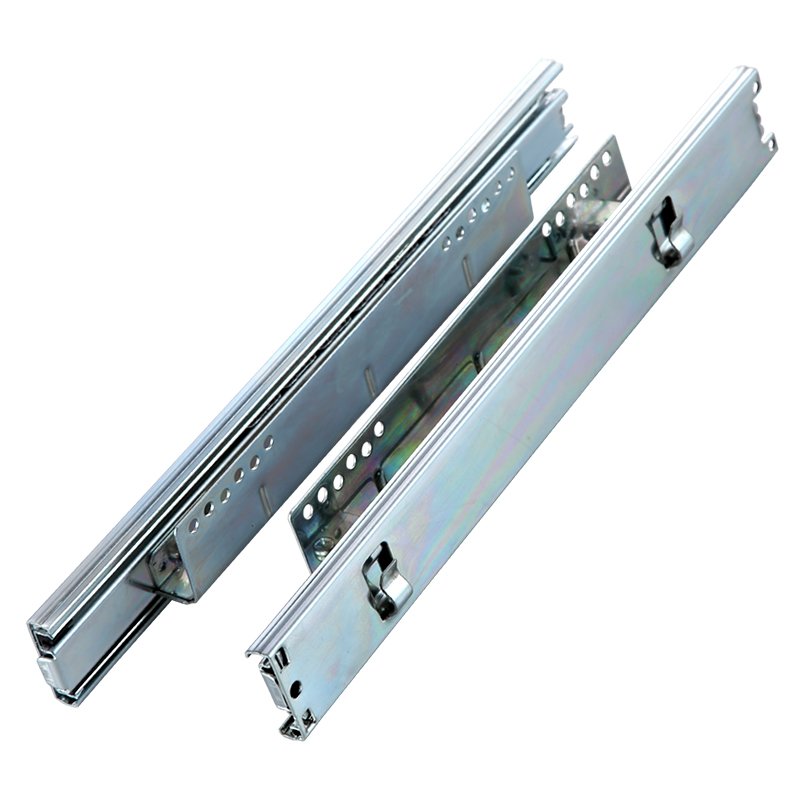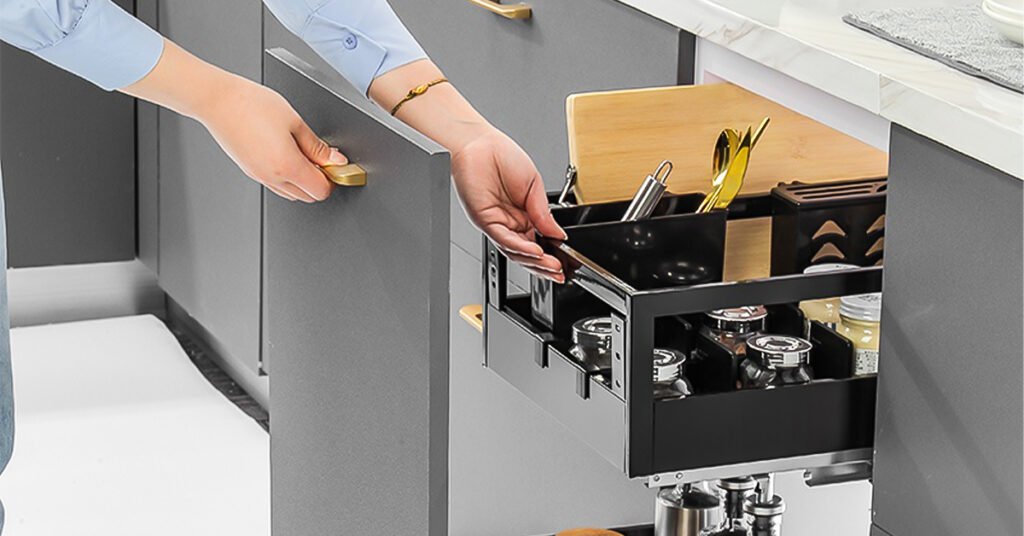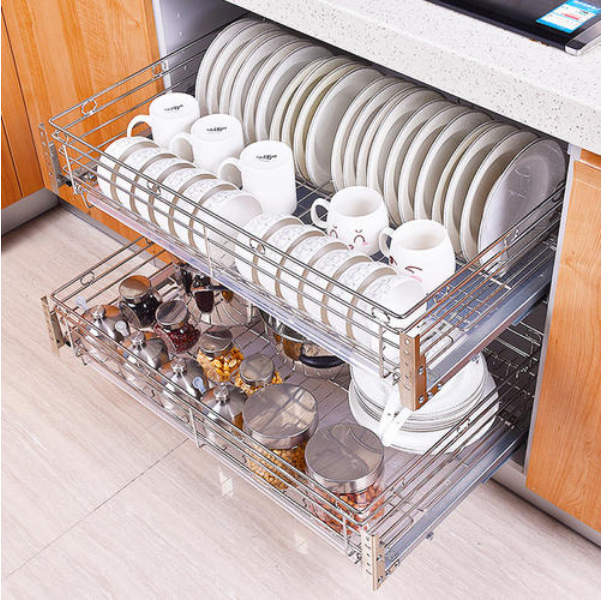drawer slides
Didn’t find the slide rail size you need? Click below to explore other models that match your preferences!

Adjustable Drawer Slides - M1245
100 lbs
Material: Cold-rolled steel/Q235
Slide width: 45mm
Installation thickness: 31.5mm
Slide length: 15″
Load bearing: 15“100 lbs (45kg)
Level of travel: Full Extension
Mounting type: Side Mount
Customizable adjustable drawer slides size, function, hole position, color, etc.
Application Segment
Specifically for kitchen pots, bowls, and baskets


Our Services
MOQ Offered
We provide flexible minimum order quantities, allowing you to start small and scale up as needed.
Large Inventory
Ensuring Ample Stock for Immediate Shipment, Eliminating Wait Times for Production.
Complete Specifications
We refine various specifications of drawer slides according to different usage scenarios.
AOLISHENG produces adjustable drawer slides with standard specifications and provides customized solutions to meet your project needs.
Why Choose AOLISHENG
Rich Experience
- 15 years of industry experience.
- Extensive customization experience.
Production Automation
- Over 90% automation in production.
- Production efficiency increased by more than 10 times.
Quality Assurance
- High-quality products certified with SGS and EN standards.
- Stringent inspection department.
Mass Production
- Factory area of over 40,000 square meters.
- Daily production capacity of over 100,000 sets.
Leading Quality
- Hundreds of professional production machines.
- 5 times product accuracy.
We Look Forward To Your Contact
AOLISHENG is your trusted global partner for high-quality drawer slide production, with strategic factories worldwide and professional local service teams. Partnering with AOLISHENG ensures efficient project delivery, robust supply chains, expert technical support, and a thriving customer base.
FAQ
Can I use shorter drawer slides?
It is possible to use shorter drawer slides, but there are a few key factors to keep in mind:
1. Fit:
Drawer Depth: The length of the slide needs to match the depth of the drawer. Using shorter slides may result in a drawer that does not fully extend or is unstable. Make sure the shorter slides are adequate for your needs.
2. Functionality:
Retraction: Short slides often only allow a drawer to be partially extended. If you need to fully extend the drawer to access the interior, a short slide may not be suitable.
Load Capacity: Shorter slides may affect load capacity, especially if the slide was designed with a specific length in mind.
3. Installation
Alignment Issues: Shorter slides may require realignment of the drawer and slide installation position. Ensure proper alignment between the slide and the drawer slot to avoid rough sliding or jamming.
Stability: Using shorter slides may affect the stability of the drawer. If the slide is shorter than necessary, the drawer may not be stable enough during movement.
4. Construction and Design
Compatibility: Make sure the short slide is compatible with the structural design of the drawer. Some slide designs and drawer structures have specific length requirements, and using an inappropriate slide may cause functional problems or damage.
5. Other considerations
Modifications and adjustments: If you use short slides, you may need to make additional modifications or adjustments to the drawer or slides to ensure their compatibility and stability.
Safety: Check whether the short slides will affect the safety of the drawer, especially when loaded, to ensure that the slides can safely carry the weight of the drawer.
Summary
It is possible to use shorter drawer slides, but you need to make sure they meet your needs and do not affect the function, stability and safety of the drawer. If the short slides meet your needs and are installed and adjusted properly, you can use them. However, if you are not sure whether it is suitable, it is recommended to use slides that match the drawer size or consult a professional for more accurate advice.
How do you match drawer slides?
There are several factors to consider when matching drawer slides:
1. Drawer size and load
Drawer size: Measure the drawer’s width, depth, and height. The length of the slide needs to match the depth of the drawer to ensure that the drawer can be pulled out smoothly.
Load capacity: Choose a slide based on the weight of the drawer. Slides are divided into light, medium, and heavy-duty. Make sure the slide you choose can handle the weight of the drawer.
2. Slide type
Side slides: Installed on the side of the drawer, common and easy to install, suitable for most standard drawers.
Bottom slides: Installed on the bottom of the drawer, suitable for situations where the slide needs to be hidden, usually used for specially designed drawers.
3. Slide length
Full telescopic slides: Allow the drawer to be fully pulled out, suitable for situations where full access to the drawer contents is required.
Partial telescopic slides: The drawer can only be pulled out partially, suitable for situations where it does not need to be fully pulled out.
4. Installation method
Side installation: The slide is installed on the side of the drawer, making sure it is aligned with the drawer slot, usually suitable for most drawers.
Bottom installation: The slide is installed on the bottom of the drawer, making sure the bottom-mounted slide is aligned with the bottom of the drawer slot.
5. Materials and Construction
Material: Slides can be steel, aluminum, or plastic. Choose the material that suits your needs.
Construction: Slides have different structural designs (such as roller type, and steel ball type). Choose the appropriate slide structure according to your usage requirements.
6. Accessories and supporting products
Make sure the slide is compatible with other accessories (such as mounting brackets, and adjustment devices) and install it according to the instructions provided by the manufacturer.
Step Summary
Measure the drawer: Determine the size and load of the drawer.
Choose the type of slide: Choose the appropriate type of slide according to the purpose of the drawer.
Match the slide length: Choose the slide length that matches the drawer depth.
Installation method: Choose the appropriate installation method according to the design of your drawer and slot.
Check accessories: Make sure the slide is compatible with the mounting bracket and other accessories.
With the above steps, you can choose and install the appropriate drawer slide. If you are unsure, you can refer to the product manual of the slide or consult a professional.
How do I measure for drawer slides?
Here are the steps to measure drawer slides:
1. Measure the dimensions of your drawer
Drawer width: Measure the width of the inside of the drawer, from one side to the other. This dimension determines whether the slide length will fit.
Drawer depth: Measure the depth of the drawer from front to back. The length of the slide needs to match the depth of the drawer to ensure that the drawer can be fully extended or partially extended as needed.
Drawer height: Although the slide length is mainly determined by the width and depth, knowing the height of the drawer can help choose the right type of slide, especially if the installation space of the slide is a consideration.
2. Measure the length of the slide
Slide length: When choosing the length of the slide, you should match the depth of the drawer. Generally, the slide length should be equal to the depth of the drawer to ensure that the drawer can be smoothly and fully extended.
3. Measure the space of the drawer slot
Drawer slot width: Measure the width of the inside of the drawer slot, that is, the distance from the inside to the inside of the drawer slot. This affects the installation width and sliding space of the slide.
Drawer slot depth: Measure the depth of the drawer slot to ensure that the slide can be installed and operate normally in the slot.
4. Consider load capacity
Weight: Choose the right slide for the estimated weight of your drawer. Heavier drawers require slides with higher load capacity.
5. Record and compare
Record all measurements and compare them to the slide specifications to ensure the slide length, load capacity, and mounting method are appropriate for your drawer.
Summary
Measure the drawer width, depth, and height.
Measure the width and depth of the drawer slot.
Choose a slide length that matches the drawer depth.
Choose the right slide for the drawer load capacity.
This ensures that the slide you choose is an exact match for the drawer and drawer slot dimensions, ensuring smooth operation once the slide is installed.
What is the rule of thumb for drawer slides?
Common “rules of thumb” for drawer slides include the following:
Slide length:
The drawer slide length should match the depth of the drawer, usually, the length of the drawer slides is equal to the depth of the drawer to ensure that the drawer can be fully extended or meet the use requirements.
Load capacity:
Consider the weight of the drawer when selecting the drawer slides. Light slides are suitable for light drawers, and medium and heavy slides are used for heavier drawers. Make sure the drawer slides has the load capacity to meet the actual use.
Smooth sliding:
Slides should be smooth and frictionless to improve the use comfort and durability. Check the sliding performance of the drawer slides to ensure that there is no jamming.
Mounting method:
Choose the appropriate mounting method based on the design of the drawer and cabinet. Common ones are side mounting and bottom mounting. Make sure the drawer slides are installed securely and meet the design requirements.
Full telescopic vs. partial telescopic:
Full telescopic slides allow the drawer to be fully extended, suitable for situations where full access is required; partial telescopic slides are suitable for situations where only partial extension is required.
Material selection:
The material of the drawer slides should be selected based on the environment in which it will be used, for example, metal slides are generally more durable, while plastic slides are suitable for light-duty use.
Following these rules of thumb can help you choose the right drawer slides to ensure the functionality and durability of your drawers.
Can you make a drawer without slides?
It is possible to make a drawer without slides, but there are some design challenges and solutions to consider. Drawers without slides usually need to rely on other methods to ensure that the drawer can open and close smoothly. Here are a few common ways to design a drawer without slides:
1. Wood groove design
Description: Create a slide between the drawer and the drawer groove, usually made of wood. This design is similar to the old drawer method, and the wood groove provides a natural sliding surface.
Pros: No additional hardware, simple and economical.
Cons: Wear and friction may occur, affecting the lifespan and smoothness.
2. Rollers or sliders
Description: Install small rollers or sliders on the bottom of the drawer to enable the drawer to slide in the drawer groove. These rollers or sliders can be made of plastic or metal.
Pros: Reduce direct friction, allowing the drawer to move more smoothly.
Cons: Requires installation and adjustment, and the rollers may accumulate dust and affect use.
3. Carpet or glide pads
Description: Install a glide pad or carpet on the bottom of the drawer groove to reduce friction between the drawer and the groove.
Pros: Simple and easy, low cost.
Disadvantages: May need to replace glides periodically, not as durable as slides.
4. Hinged Design
Description: Hinges are installed on the side of the drawer, allowing the drawer to open and close like a door. This design is often used for special furniture or custom projects.
Pros: Can create unique opening and closing methods, suitable for specific designs.
Disadvantages: Complex design, may require custom manufacturing.
5. Slots or Guides
Description: Use a simple slot or guide system to guide the movement of the drawer, these guides can be wood or metal.
Pros: Provides stability and guidance while reducing friction.
Disadvantages: May require precise manufacturing and installation.
Summary
While it is possible to make drawers without slides, when choosing these alternatives, you need to consider the smoothness of use, durability, and ease of maintenance. If you can, drawer slides generally provide a better experience and longer life. If you do not use drawer slides, make sure the method used effectively supports the normal use of the drawer.
